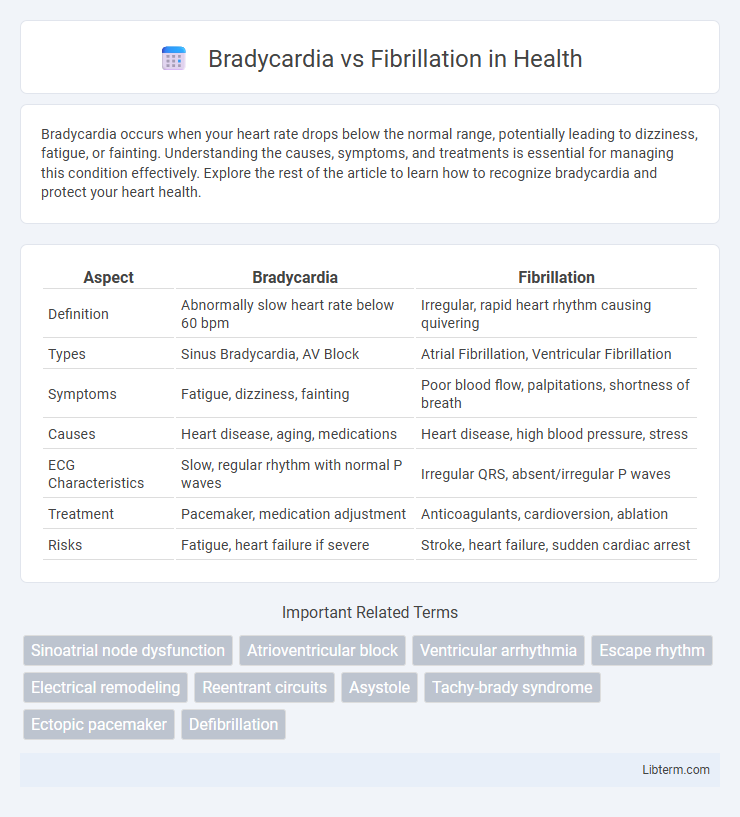Bradycardia occurs when your heart rate drops below the normal range, potentially leading to dizziness, fatigue, or fainting. Understanding the causes, symptoms, and treatments is essential for managing this condition effectively. Explore the rest of the article to learn how to recognize bradycardia and protect your heart health.
Table of Comparison
| Aspect | Bradycardia | Fibrillation |
|---|---|---|
| Definition | Abnormally slow heart rate below 60 bpm | Irregular, rapid heart rhythm causing quivering |
| Types | Sinus Bradycardia, AV Block | Atrial Fibrillation, Ventricular Fibrillation |
| Symptoms | Fatigue, dizziness, fainting | Poor blood flow, palpitations, shortness of breath |
| Causes | Heart disease, aging, medications | Heart disease, high blood pressure, stress |
| ECG Characteristics | Slow, regular rhythm with normal P waves | Irregular QRS, absent/irregular P waves |
| Treatment | Pacemaker, medication adjustment | Anticoagulants, cardioversion, ablation |
| Risks | Fatigue, heart failure if severe | Stroke, heart failure, sudden cardiac arrest |
Understanding Bradycardia and Fibrillation
Bradycardia is a condition characterized by a slower than normal heart rate, typically below 60 beats per minute, which can lead to insufficient blood flow to the body. Fibrillation, including atrial fibrillation and ventricular fibrillation, involves rapid, irregular heart rhythms causing ineffective heart contractions and increased risk of stroke and cardiac arrest. Understanding the distinct electrical disruptions in bradycardia and fibrillation is crucial for accurate diagnosis and targeted treatment interventions.
Key Differences Between Bradycardia and Fibrillation
Bradycardia is characterized by an abnormally slow heart rate, typically below 60 beats per minute, caused by issues in the heart's electrical conduction system. Fibrillation refers to rapid, irregular heartbeats, with atrial fibrillation and ventricular fibrillation being the most common types, leading to ineffective heart contractions and potential blood clots. Key differences include heart rate variations, rhythm regularity, and underlying risks: bradycardia slows the heart rate but maintains rhythm, while fibrillation causes chaotic electrical activity disrupting normal rhythm and cardiac output.
Causes of Bradycardia
Bradycardia primarily results from disruptions in the heart's electrical conduction system, including sinoatrial node dysfunction or atrioventricular block. Common causes include aging, ischemic heart disease, hypothyroidism, electrolyte imbalances, and certain medications such as beta-blockers or calcium channel blockers. Unlike fibrillation, which involves rapid and irregular heart rhythms, bradycardia is characterized by a slower-than-normal heart rate, often below 60 beats per minute.
Causes of Fibrillation
Fibrillation primarily results from abnormal electrical signals in the heart, often triggered by conditions such as ischemic heart disease, hypertension, and atrial enlargement. Other causes include electrolyte imbalances, hyperthyroidism, and excessive alcohol consumption. Unlike bradycardia, which involves slow heart rhythms due to sinus node dysfunction or conduction block, fibrillation causes rapid, irregular heartbeats disrupting effective blood flow.
Common Symptoms to Recognize
Common symptoms of bradycardia include fatigue, dizziness, and shortness of breath due to the heart's slow rate limiting oxygen supply. In contrast, fibrillation, such as atrial fibrillation, typically presents with palpitations, irregular heartbeat, and chest discomfort caused by erratic electrical signals. Recognizing these distinctive symptoms is essential for timely diagnosis and treatment of these cardiac arrhythmias.
Diagnostic Methods for Arrhythmias
Electrocardiogram (ECG) is the primary diagnostic tool differentiating Bradycardia, characterized by a slow heart rate below 60 beats per minute, from Fibrillation, which involves irregular, rapid heartbeats such as Atrial Fibrillation or Ventricular Fibrillation. Holter monitoring and event recorders provide continuous heart rhythm analysis to detect intermittent arrhythmias not captured during a standard ECG. Electrophysiological studies offer invasive mapping of electrical pathways, aiding in precise diagnosis and treatment planning for complex arrhythmias.
Treatment Options for Bradycardia
Bradycardia treatment primarily involves addressing underlying causes such as hypothyroidism or medication side effects and may require the use of pacemaker implantation for persistent symptomatic cases to regulate heart rhythm. Pharmacological options include atropine administration in acute settings to increase heart rate, while in some patients, adjusting or discontinuing negative chronotropic drugs like beta-blockers is essential. In severe instances, temporary pacing or permanent pacemaker therapy remains the most effective intervention to prevent complications related to low heart rate.
Managing Fibrillation: Therapies and Interventions
Management of fibrillation primarily involves anticoagulation therapy to prevent stroke and rhythm control using antiarrhythmic drugs or electrical cardioversion. Catheter ablation is a highly effective intervention for patients with atrial fibrillation refractory to medication, targeting the pulmonary vein foci responsible for abnormal electrical signals. Rate control with beta-blockers, calcium channel blockers, or digoxin remains critical to prevent tachycardia-induced cardiomyopathy and improve patient outcomes.
Complications and Health Risks
Bradycardia, characterized by an abnormally slow heart rate, can lead to complications such as fatigue, dizziness, and in severe cases, heart failure or sudden cardiac arrest due to insufficient blood flow. Fibrillation, including atrial fibrillation, increases the risk of stroke, heart failure, and other thromboembolic events caused by irregular and rapid heartbeats that impair effective blood circulation. Both conditions demand timely diagnosis and management to prevent long-term cardiovascular damage and reduce the risk of life-threatening complications.
Prevention and Lifestyle Recommendations
Bradycardia prevention focuses on maintaining a heart-healthy lifestyle, including regular cardiovascular exercise, balanced diet rich in fruits and vegetables, and avoiding excessive alcohol and tobacco use to support optimal heart rhythm. Fibrillation, such as atrial fibrillation, often benefits from managing underlying conditions like hypertension, diabetes, and obesity, along with consistent medical monitoring and stress reduction techniques. Both conditions improve with routine check-ups, adherence to prescribed medications, and lifestyle modifications that promote stable heart function and reduce arrhythmia risk.
Bradycardia Infographic

 libterm.com
libterm.com